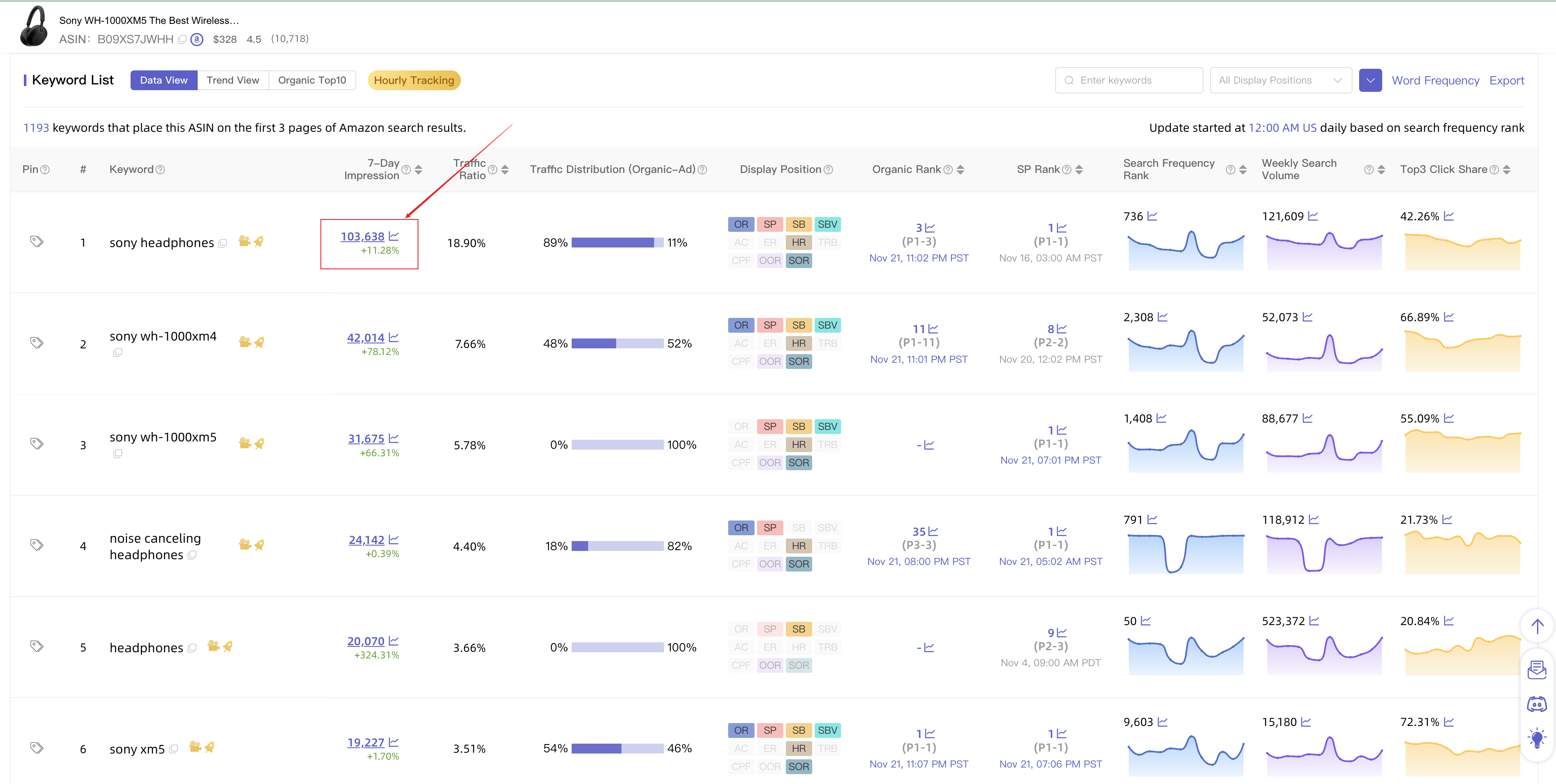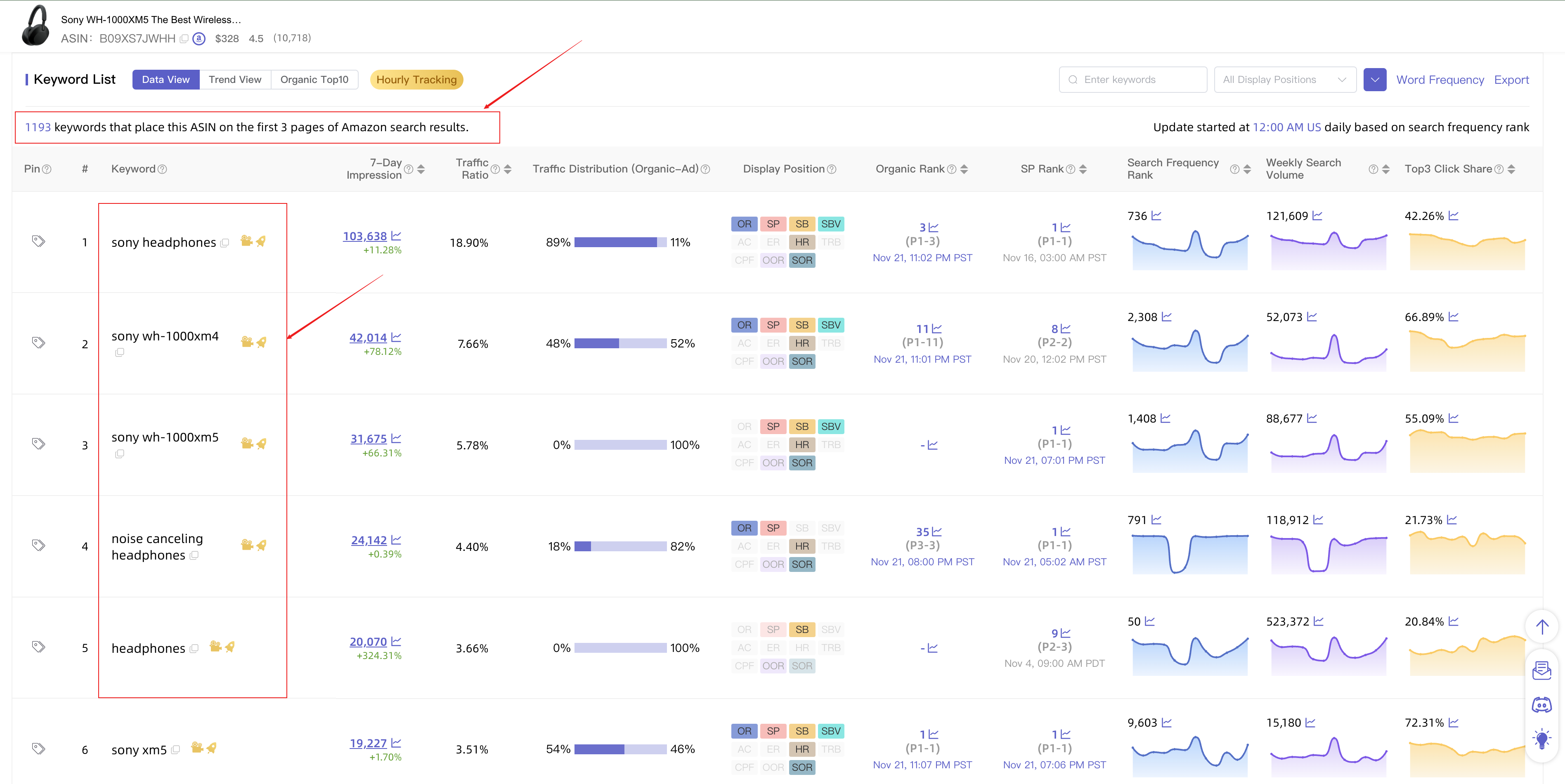FAQs

Which Amazon sites does ASINSIGHT support?
Presently, our support extends across nine prominent Amazon marketplaces, encompassing the US, Germany, UK, Japan, Canada, France, Spain, Italy, and Mexico.
Where does our hourly Amazon keyword ranking data come from?
All our data is sourced from Amazon Brand Analytics Weekly Report (ABA Weekly Report) and Amazon website.
- Hourly Keyword Ranking Data For the top 100,000 keywords on the US site, top 50,000 keywords on the UK site, and top 50,000 keywords on the German site, we retrieve ASIN's keyword ranking data by scraping Amazon's official keyword search result pages every hour, enabling users to monitor real-time changes in keyword rankings for their own products and competitors. The use of official Amazon data sources and hourly update frequency ensures the precision of all our data.
- Distinctive data dimensions for analyzing keywords We utilize Amazon Brand Analytics Weekly Reports' ranking data and hourly ASIN keyword ranking as our benchmark data. Through our proprietary algorithm, we assist sellers in obtaining data such as weekly keyword search volume, 7-day ASIN display volume on keyword result pages, the proportion of traffic brought by different keywords, daily traffic scores, and trends. This empowers sellers to make quicker and more accurate assessments of their ASINs' keyword traffic trends and patterns.
Is the data provided by ASINSIGHT accurate?
The majority of the data we provide is derived from the ABA report. We offer hourly ranking data for the top 100,000 keywords in the U.S., and the top 50,000 in the U.K. and Germany, based on the latest ABA report. With a rapid data update rate and traffic data calculated based on hourly rankings, we can ensure relative accuracy in our data.
ASINSIGHT captures rankings using the fixed postal code 90001, and by scraping through local servers using local IP addresses, ensuring the authenticity and reliability of the data.
Is an API service currently provided for use?
ASINSIGHT does not provide an API service. If needed, you can email your specific data inquiry to support@asinsight.ai, and we will respond ASAP.
How is the 7-Day Traffic Score for ASINSIGHT calculated ?
- Organic Traffic Score: Obtained by multiplying the search result's organic impression by a constant. It is directly proportional to the organic impression of the search results in the last 7 days (excluding the current day) (Organic positions include: organic ranking, AC , ER , organic position in CPF , OOR ). The higher the score, the higher the organic impression. The percentage in brackets represents the proportion of organic traffic value to the total traffic value.
- Ad Traffic Score: Obtained by multiplying the search result's Ad impression by a constant. It is directly proportional to the Ad impression of the search results (Ad positions include: SP, SB, SBV, HR , TRB , Ad position in CPF , SOR ). The higher the score, the higher the Ad impression. The percentage in brackets represents the proportion of Ad traffic to the total traffic.
PS: The 7-day traffic score is a concept introduced by ASINSIGHT to calculate the display volume obtained by an ASIN on the first 3 pages of keyword search results, including both Organic and Ad traffic.
Why multiply by a constant?
---- This is because the total display volume for an ASIN across all keywords is very large and not convenient for comparison. By multiplying the display volume by a constant, it is proportionally reduced, making it easier to compare data.
What displays does the 7-Day Impression of ASINSIGHT calculate, and how is it calculated?
- Calculation Method: The 7-day display volume represents the display volume on the first 3 pages of keyword search result pages for the ASIN over the past 7 days (excluding the current day), including natural rankings, SP ad rankings, SB ads, SBV ads, ER recommendations, and other recommended positions.
- This display volume only includes the display volume on the search results pages and does not include the display volume in the ad positions and recommended spots on the product pages. Therefore, the keyword ad display volume seen in the ad backend will be 2-30 times larger than the data here (the multiple varies according to different ad types and can be seen in the display volume proportion of different ad positions in the ad campaign).
- Factors affecting the size of the 7-day display volume: The size of the "Search Frequency Rank" and the ranking of the ASIN on the keyword search results page.
a. The larger "Search Frequency Rank", the larger the impression.
b. The higher the ranking of the ASIN on the keyword search results page, the larger the impression.
- Time Period for the 7-day Display Volume: Data for the 7 days not including today. Example: If today is April 24th, then the 7-day Impression will include data from April 17th to 23rd.
- Note: The 7-Day Impression does not include data for the current day. If the ASIN did not have a ranking in the previous 7 days but does have a ranking today, there may be a situation where there is a Organic or Ad ranking, but the traffic value is 0.

What do TOP3 Click Share and TOP3 Share Conversion mean? What can they be used for?
- TOP3 Click Share: In an ABA report, it represents the sum of the click shares of the top 3 ASINs that receive the most clicks, indicating the concentration of clicks.
- Click Share: This is defined by Amazon as the number of times a specific product is clicked after a consumer searches for a specific term, divided by the total number of times any product is clicked after that search term is used.
- TOP3 Conversion Share: In an ABA report, it represents the sum of the conversion shares of the top 3 ASINs that convert the most, indicating the concentration of purchase conversions.
- Conversion Share: This refers to the number of times a specific product is conversed after a consumer searches for a specific term, divided by the total number of times any product is conversed following that search. Click share and conversion share are independent of each other, and conversion share can be higher than click share.
- PS: By analyzing the TOP3 Click Share and TOP3 Conversion Share, one can determine the degree of monopoly the TOP ASINs have over certain keywords. This helps to consider whether to strategically invest in advertising for those keywords.

How are keywords derived from a reverse ASIN lookup? / How are words captured in the keyword list?
- The keyword list obtained after a reverse ASIN lookup accounts for keywords that have appeared on the first 3 pages of search results for the ASIN within the last 30 days.
- Why only capture data from the first 3 pages: It's because only the first 3 pages have a significant amount of exposure. Beyond the third page, the visibility of the ASIN drops sharply, and user search habits typically do not extend beyond the third page.

How often is the data from ASINSIGHT captured and updated?
- Updated hourly: Keyword Organic Rank and Ad Rank (latest ABA report for the top 100,000 keywords in the US, and the top 50,000 in the UK and Germany), Ad Rotation Tracker and Organic Rotation Tracker.
- Updated daily: 7-Day Traffic Score, ASIN/Keyword Traffic Trends, 7-Day Impression/Traffic Ratio/Traffic Distribution, Traffic Insight, Ad Insight, Organic Traffic Score, and Ad Traffic score.
- Updated weekly: Weekly Search Volume, data in the ABA report including Search Frequency Rank, TOP3 Click Share, TOP3 Conversion Share, and the TOP3 ASINs.
What is the difference between Traffic Ratio and Traffic Share in Multi-ASIN Analysis?
1.Traffic Share: the proportion of the 7-Day Impression of the compared ASINs for a particular keyword out of the total 7-Day impression for all compared ASINs.
- Traffic Ratio: the proportion of the search page impression for an ASIN under a specific keyword out of the ASIN's total search page impression.

Which Display Positions are currently captured, and what do they specifically mean?
The currently captured display positions are:
- Organic: The natural ranking in search results.
- SP (Sponsored Product): Product promotion through SP ads.
- SB (Sponsored Brand): Brand promotion through SB ads.
- SBV (Sponsored Brand Video): Video advertisements for brand promotion.
- AC (Amazon Choice): Amazon’s recommendation for products based on value and customer reviews.
- ER (Editorial Recommendations): Products recommended by editors based on product testing and research.
- HR (Highly Rated): Products that have received high customer ratings.
- TRB (Top Rated From Our Brands): High-rated brand section, including Amazon’s own brands like Amazon Exclusives and other highly rated products by Amazon’s brands.
- CPF (Climate Pledge Friendly): Products that meet sustainability certifications; this section includes both organic and ad placements, and the traffic is calculated separately for organic and advertising.
- OOR (Organic Other Recommendations): Other organic recommendation spots, including New Arrivals, Featured From The Store, and other spots that drive organic traffic.
- SOR (Sponsored Other Recommendations): Other advertising recommendation spots, including Trending Now, Other Items to Consider, and additional spots that drive ad traffic.
Note: SD (Sponsored Display) ads are not captured, hence not displayed.
Additionally, if a ranking position has not been captured in the past 7 days, the position label will lighten in color, and if not captured for over 30 days, the label will turn gray.
